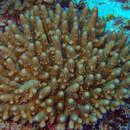tr
kırıntılardaki isimler


Acropora globiceps is a species of acroporid coral found in the oceanic central and western Pacific Ocean and central Indo-Pacific. It can also be found in the Great Barrier Reef, the Philippines, the Andaman Islands, Polynesia, Micronesia and the Pitcairn Islands. It occurs on the slopes of reefs, the flats of reefs, in tropical shallow reefs, and at depths of around 8 metres (26 ft). It was described by Dana in 1846.
Acropora globiceps occurs in small digitate colonies consisting of compact branches. Its corallites are of no specific size; specimens on slopes of reefs have had tube-shaped corallites, and specimens on reef flats have had corallites built into the branches. The axial corallites are small, and the radial corallites may be ordered in rows. It is cream or blue in colour. It looks similar to Acropora gemmifera, Acropora monticulosa, Acropora retusa, and Acropora secale.[2]
It is classed as a vulnerable species on the IUCN Red List and it is believed that its population is decreasing; it is also listed under Appendix II of CITES. Figures of its population are unknown, but is likely to be threatened by the global reduction of coral reefs, the increase of temperature causing coral bleaching, climate change, human activity, the crown-of-thorns starfish (Acanthaster planci) and disease.[1] It is found in the central and western Pacific Ocean and the central Indo-Pacific, including the Great Barrier Reef, the Andaman Islands, the Philippines, Polynesia, the Pitcairn Islands, and Micronesia. It is found at around 8 metres (26 ft) below the surface.[1]
It was described as Madrepora globiceps by Dana in 1846.[3]
Acropora globiceps is a species of acroporid coral found in the oceanic central and western Pacific Ocean and central Indo-Pacific. It can also be found in the Great Barrier Reef, the Philippines, the Andaman Islands, Polynesia, Micronesia and the Pitcairn Islands. It occurs on the slopes of reefs, the flats of reefs, in tropical shallow reefs, and at depths of around 8 metres (26 ft). It was described by Dana in 1846.
Acropora globiceps est une espèce de coraux appartenant à la famille des Acroporidae.
Ce corail forme de petites colonies de type digitées (en forme de doigts), de couleur crème parfois teintée de bleu. La taille et l'apparence de branches dépendent du degré d'exposition à l'action de vague, mais elles sont toujours courtes et disposées de manière compacte. Les colonies de milieu très exposé ont des branches en forme de pyramide ; suivant l'exposition, elles sont plus élancées, mais toujours assez robustes, et généralement arrondies (d'où leur nom latin). Les corallites sont de taille irrégulière, ceux des colonies situées sur des pentes de récif sont tubulaires, ceux sur des colonies d'arrière-récif sont plus trapus. Le corallite axial est petit et parfois indiscernable. Les corallites radiaux sont de taille irrégulière, et forment parfois des rangées verticales le long des branches[2].
On rencontre cette espèce de l'océan Indien central au Pacifique ouest et central[2].
Acropora globiceps est une espèce de coraux appartenant à la famille des Acroporidae.
Acropora globiceps là một loài san hô trong họ Acroporidae. Loài này được Dana mô tả khoa học năm 1846.
Acropora globiceps là một loài san hô trong họ Acroporidae. Loài này được Dana mô tả khoa học năm 1846.